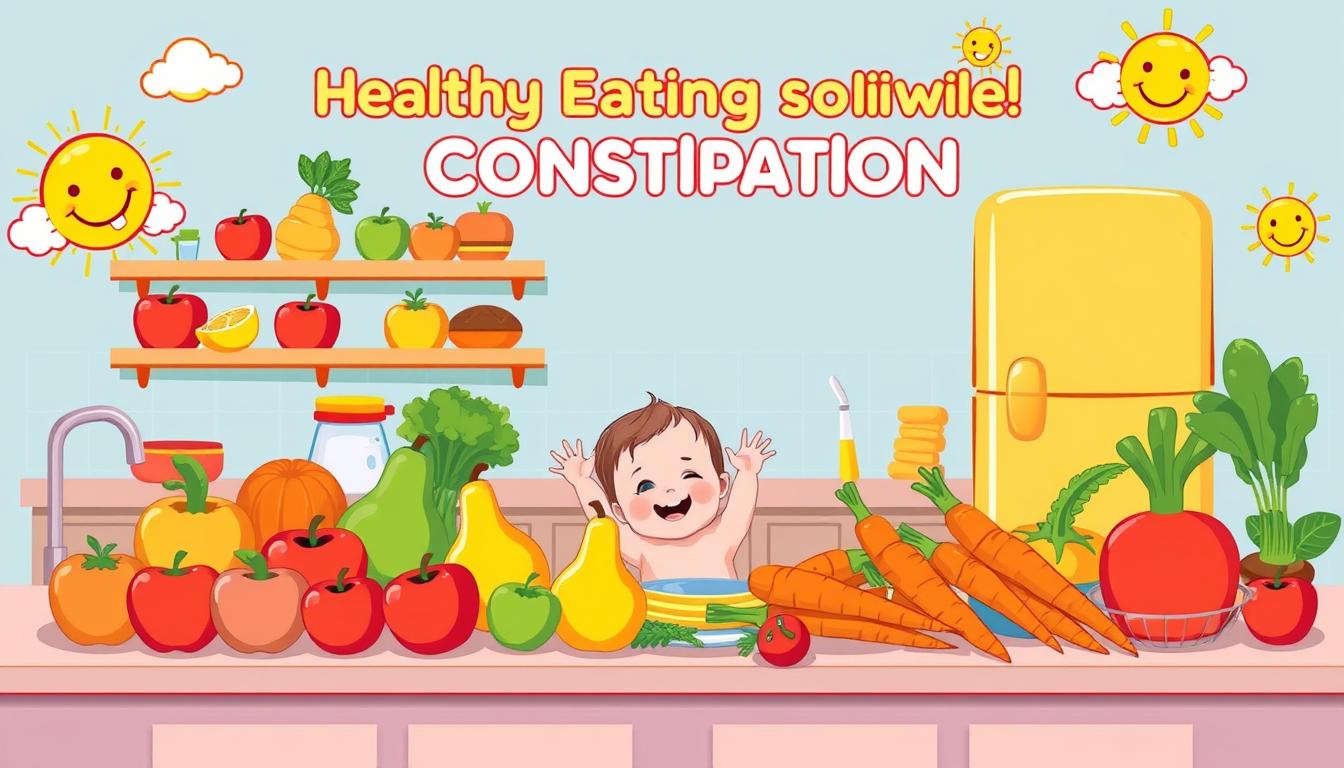Dealing with infant colic can be tough for new parents. This guide offers practical solutions and effective strategies. We’ll look at medical and natural remedies to ease your baby’s discomfort.
Best Treatment of colic in infants
Key Takeaways
- Understand the signs and symptoms of infant colic to identify the condition early on
- Explore a variety of medical and natural remedies to find the most effective approach for your baby
- Discover soothing techniques and holding positions that can calm a colicky infant
- Learn about dietary modifications for breastfeeding mothers and the role of probiotics in managing colic
- Recognise when to seek professional medical help and identify red flags that require immediate attention
Understanding Infant Colic: Signs and Symptoms
Infant colic is a common issue that many newborns face. It causes distress for both the baby and the parents. Unlike normal crying, colic has its own signs and patterns that need attention.
Common Behavioural Patterns in Colicky Babies
Colicky babies cry intensely and inconsolably for hours. They might clench their fists, pull their legs up, and have a red face. These episodes usually happen in the late afternoon or evening, leaving parents feeling exhausted.
When Normal Crying Becomes Colic
Parents need to know the difference between normal crying and colic. Colic is marked by long, high-pitched wailing that’s hard to soothe. Unlike normal crying, which lasts 2-3 hours a day, colic can last 3 or more hours, several days a week.
Impact on Parents and Family Life
Dealing with a colicky baby is tough for parents and the whole family. The constant crying can cause stress, sleep loss, and feelings of helplessness. It’s key for parents to find support and learn soothing techniques for colic to manage the condition.
“Colic can be one of the most challenging and isolating experiences for new parents. It’s crucial to remember that it’s a temporary phase and there are ways to help soothe your baby and manage the condition.”
Treatment of Colic in Infants: Medical Approaches
Medical treatments can help ease colic in infants. Paediatricians suggest various methods to reduce the distress of this common condition.
Simethicone drops are a common treatment. These drops help release trapped gas in the baby’s stomach. They might lessen the severity and length of colic episodes.
Healthcare providers might also prescribe anti-colic medications. These include anti-spasmodics or simeticone-based formulas. They relax the intestines or cut down gas, offering relief to colicky babies.
Probiotics are also being explored for colic management. Certain probiotics, when recommended by a doctor, can balance gut bacteria. This might help ease colic symptoms.
| Medical Treatments for Colic | Description |
|---|---|
| Simethicone Drops | Over-the-counter gas-relieving medication to help break up and expel trapped gas |
| Anti-colic Medications | Prescription medications, such as anti-spasmodics or simeticone-based formulations, to relax the intestinal muscles and reduce gas production |
| Probiotics | Beneficial bacteria that may help restore gut flora and alleviate colic symptoms |
Remember, while these treatments can help, always talk to a paediatrician first. They can guide you on the best treatment for your baby’s colic. This ensures the treatment is safe and effective.
Natural Remedies and Home Solutions
Looking for ways to soothe your baby’s colic? Natural remedies and home solutions can help. From herbal teas to essential oils and safe homeopathic treatments, these gentle methods might ease your baby’s discomfort.
Herbal Tea Options for Colic Relief
Some herbal teas are known to help with colic in babies. Chamomile, fennel, and ginger teas are good for soothing. They can help reduce gas, bloating, and fussiness. You can give these teas to your baby, either directly or mixed into breastmilk or formula.
Essential Oils and Their Benefits
Essential oils can offer natural relief for colicky babies when used safely. Lavender oil is calming, while Peppermint oil can ease tummy troubles. Always mix essential oils with a carrier oil before applying to the skin. Make sure to avoid putting them on your baby’s face.
Safe Homeopathic Treatments
Homeopathic remedies like Calcarea Carbonica and Chamomilla can help with colic. They address digestive issues and irritability. Always get these remedies from a qualified homeopathic practitioner to ensure they’re safe and effective.
Before trying any natural remedies for your baby’s colic, talk to your pediatrician. They can tell you which ones are safe and won’t interfere with other treatments. With the right natural solutions, you can help soothe and comfort your baby.
Effective Soothing Techniques and Holding Positions
Dealing with a colicky baby can be tough for parents. But, there are ways to calm fussy babies and ease colic discomfort. Let’s look at some effective methods to soothe and manage colic.
The “Colic Hold”
The “colic hold” is a well-known technique. It involves holding the baby in a certain way. Sit or stand and hold the baby against your chest, with their head on your shoulder.
Gently rock back and forth or walk while supporting the baby’s head and back. This can ease colic symptoms and comfort the baby.
Swaddling for Colic Relief
Swaddling is another good way to calm colicky babies. Wrap the baby snugly in a blanket, with their arms close to their body. It makes them feel secure, like in the womb.
When done right, swaddling can soothe colicky infants and help them sleep better.
Using White Noise
White noise is great for soothing colicky babies. The constant sound can block out other noises that might upset them. Use a white noise machine, a fan, or a smartphone app to create a calming atmosphere.
Remember, every baby is different. It might take some time to find what works best for your baby. Be patient and seek help from healthcare professionals if needed.
TO WATCH VIDEO CLICK HERE
Dietary Modifications for Breastfeeding Mothers
As a breastfeeding mom, what you eat can really affect your baby’s colic. Making smart food choices can help ease your baby’s discomfort. Let’s look at the important foods to avoid and the ones that can help.
Foods to Avoid While Nursing
- Spicy, fried, or highly processed foods
- Caffeine-rich beverages like coffee, tea, and sodas
- Alcoholic drinks
- Cruciferous vegetables like broccoli, cauliflower, and cabbage
- Citrus fruits and juices
- Dairy products, especially cow’s milk
Beneficial Foods for Reducing Colic
- Fennel, chamomile, and anise tea
- Probiotics-rich foods like yogurt, kefir, and fermented vegetables
- Whole grains, such as oats and brown rice
- Lean proteins like chicken, fish, and legumes
- Anti-inflammatory herbs and spices, including ginger and turmeric
Supplementation Guidelines
Your healthcare provider might suggest supplementation to ease your baby’s colic. They might recommend:
- Probiotics to support gut health
- Omega-3 fatty acids to reduce inflammation
- Simethicone to help expel gas
- Herbal remedies like fennel, chamomile, or colic calm
Always talk to your doctor or a lactation specialist before trying new supplements or changing your diet.
“A mother’s diet can have a profound impact on her breastfed baby’s colic symptoms. By making mindful food choices, you can provide your little one with much-needed relief.”
The Role of Probiotics in Managing Colic
Parents dealing with colic are finding new hope in probiotic supplements. Research shows that certain probiotics might help ease colic in infants. This brings relief to babies and their families.
Probiotics for colic have caught the eye of scientists lately. Studies point to probiotics like Lactobacillus reuteri helping with colic. They think these good bacteria improve gut health and immune function, easing colic symptoms.
It’s key to get advice from doctors on using probiotics for colic. The right dose and how long to use them can vary. Always talk to a paediatrician or healthcare expert to use these supplements safely and effectively.
| Probiotic Strain | Potential Benefits for Colic |
|---|---|
| Lactobacillus reuteri | Shown to reduce the duration and severity of colic episodes in infants |
| Bifidobacterium animalis | May help regulate digestive function and alleviate colic symptoms |
| Lactobacillus rhamnosus | Preliminary research suggests it may be beneficial for colic management |
Probiotics show promise for treatment of colic in infants. But, we need more research on their long-term effects and best doses. Still, the current evidence suggests probiotics could be a natural, effective way to manage colic.
Baby Massage Techniques for Colic Relief
Caring for a colicky baby can be tough for parents. But, gentle baby massage can help a lot. These special techniques meet the needs of colicky babies, offering a natural way to ease their pain and help them relax.
Step-by-Step Massage Guide
Start by making sure your baby is comfy and warm. Use soft, circular motions to massage their tummy, focusing on the lower part. This can help get rid of trapped gas and ease belly pain.
Then, massage their legs, feet, and back with long, smooth strokes. This helps them feel calm.
Adjust the pressure and style based on how your baby reacts. Some like it light, while others need it firmer. Pay attention to what they show you and change as needed.
Best Times for Massage
- Do baby massage right before or after feeding to ease tummy troubles.
- Make massage a part of your baby’s daily routine, like during bath time or before bed, to create a soothing ritual.
- Try a quick massage when your baby shows signs of colic, like crying a lot, being fussy, or having belly pain.
Regular, gentle baby massage is a strong tool against colic. By adding these methods to your care routine, you can give your baby the relief they need and help them feel more comfortable and happy.
“Massage can be a valuable addition to the toolbox for parents dealing with colic. It’s a natural, safe way to soothe and comfort your baby.”
Environmental Factors and Colic Management
Dealing with newborn colic can be tough. But knowing how the environment affects it can help. A calm and comfy space is key to easing colic and bringing peace to both baby and parents.
The nursery’s lighting is important. Soft, dim light can really help, as bright light can upset a colicky baby. Try dimmers, lamps, or blackout curtains to find the perfect calm.
Temperature is also crucial. Keep the nursery at 68-72°F (20-22°C) to avoid overheating or chilling. Dress your baby in light, breathable clothes and watch the room’s temperature.
Noise levels matter a lot in managing colic management and preventing colic in newborns. Avoid loud or sudden sounds like TV, music, or appliances. Use a white noise machine or nature sounds to soothe your baby.
| Environmental Factor | Recommendations for Colic Management |
|---|---|
| Lighting | Soft, dim lighting; use dimmers, lamps, or blackout curtains |
| Temperature | Maintain a comfortable, consistent temperature between 68-72°F (20-22°C) |
| Noise | Minimize loud or sudden sounds; use white noise machines or soothing nature sounds |
Creating a soothing environment can ease your baby’s colic. Try different changes and see what works best for your little one’s comfort and calm.
When to Seek Professional Medical Help
Colic can be tough for parents to handle. It’s key to know when to get medical help. Some signs are clear warnings of bigger issues.
Red Flags and Warning Signs
Watch out for signs like persistent vomiting, fever, or diarrhea in your baby. These could mean a serious gut problem. Also, if your baby cries for over three hours a day, it’s time to see a doctor.
Available Medical Interventions
If home remedies don’t work, a doctor might suggest other options. They could change your diet if you’re breastfeeding or give special formula. They might also prescribe medicine for pain or gas. Sometimes, they’ll recommend probiotics or other treatments to ease colic symptoms.
FAQ
What are the most common signs and symptoms of infant colic?
Signs of infant colic include intense, high-pitched crying that lasts for hours. This crying often happens in the evening. Colicky babies may also show flushed cheeks, clenched fists, and a tense body.
How can I soothe a colicky baby?
To soothe a colicky baby, try gentle rocking, swaying, and shushing. White noise can also help. The “colic hold” is another method, where you hold your baby against your chest.
What dietary modifications can help reduce colic in breastfed babies?
Breastfeeding mothers should avoid dairy, spicy foods, and cruciferous vegetables. These can cause colic in some babies. Adding probiotic-rich foods or supplements to the mother’s diet may also help.
Can baby massage help alleviate colic symptoms?
Yes, gentle baby massage can soothe a colicky baby. Start by massaging their abdomen in a clockwise motion. Also, massage their legs and feet. Use a safe, gentle oil or lotion.
When should I seek medical help for my baby’s colic?
Seek medical help if your baby’s colic is severe or lasts beyond 3 months. Also, if it’s accompanied by fever, vomiting, or diarrhoea. Your paediatrician can check for any underlying conditions and offer treatment.
TO SEE MORE TOPICS CLICK HERE



